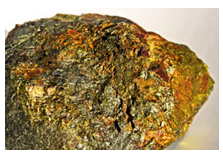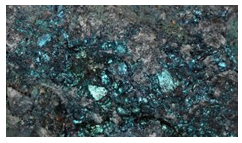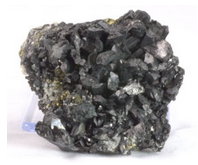14.3.1: Tetrahedral Sulfides and Arsenides
- Page ID
- 18654
\( \newcommand{\vecs}[1]{\overset { \scriptstyle \rightharpoonup} {\mathbf{#1}} } \)
\( \newcommand{\vecd}[1]{\overset{-\!-\!\rightharpoonup}{\vphantom{a}\smash {#1}}} \)
\( \newcommand{\dsum}{\displaystyle\sum\limits} \)
\( \newcommand{\dint}{\displaystyle\int\limits} \)
\( \newcommand{\dlim}{\displaystyle\lim\limits} \)
\( \newcommand{\id}{\mathrm{id}}\) \( \newcommand{\Span}{\mathrm{span}}\)
( \newcommand{\kernel}{\mathrm{null}\,}\) \( \newcommand{\range}{\mathrm{range}\,}\)
\( \newcommand{\RealPart}{\mathrm{Re}}\) \( \newcommand{\ImaginaryPart}{\mathrm{Im}}\)
\( \newcommand{\Argument}{\mathrm{Arg}}\) \( \newcommand{\norm}[1]{\| #1 \|}\)
\( \newcommand{\inner}[2]{\langle #1, #2 \rangle}\)
\( \newcommand{\Span}{\mathrm{span}}\)
\( \newcommand{\id}{\mathrm{id}}\)
\( \newcommand{\Span}{\mathrm{span}}\)
\( \newcommand{\kernel}{\mathrm{null}\,}\)
\( \newcommand{\range}{\mathrm{range}\,}\)
\( \newcommand{\RealPart}{\mathrm{Re}}\)
\( \newcommand{\ImaginaryPart}{\mathrm{Im}}\)
\( \newcommand{\Argument}{\mathrm{Arg}}\)
\( \newcommand{\norm}[1]{\| #1 \|}\)
\( \newcommand{\inner}[2]{\langle #1, #2 \rangle}\)
\( \newcommand{\Span}{\mathrm{span}}\) \( \newcommand{\AA}{\unicode[.8,0]{x212B}}\)
\( \newcommand{\vectorA}[1]{\vec{#1}} % arrow\)
\( \newcommand{\vectorAt}[1]{\vec{\text{#1}}} % arrow\)
\( \newcommand{\vectorB}[1]{\overset { \scriptstyle \rightharpoonup} {\mathbf{#1}} } \)
\( \newcommand{\vectorC}[1]{\textbf{#1}} \)
\( \newcommand{\vectorD}[1]{\overrightarrow{#1}} \)
\( \newcommand{\vectorDt}[1]{\overrightarrow{\text{#1}}} \)
\( \newcommand{\vectE}[1]{\overset{-\!-\!\rightharpoonup}{\vphantom{a}\smash{\mathbf {#1}}}} \)
\( \newcommand{\vecs}[1]{\overset { \scriptstyle \rightharpoonup} {\mathbf{#1}} } \)
\( \newcommand{\vecd}[1]{\overset{-\!-\!\rightharpoonup}{\vphantom{a}\smash {#1}}} \)
\(\newcommand{\avec}{\mathbf a}\) \(\newcommand{\bvec}{\mathbf b}\) \(\newcommand{\cvec}{\mathbf c}\) \(\newcommand{\dvec}{\mathbf d}\) \(\newcommand{\dtil}{\widetilde{\mathbf d}}\) \(\newcommand{\evec}{\mathbf e}\) \(\newcommand{\fvec}{\mathbf f}\) \(\newcommand{\nvec}{\mathbf n}\) \(\newcommand{\pvec}{\mathbf p}\) \(\newcommand{\qvec}{\mathbf q}\) \(\newcommand{\svec}{\mathbf s}\) \(\newcommand{\tvec}{\mathbf t}\) \(\newcommand{\uvec}{\mathbf u}\) \(\newcommand{\vvec}{\mathbf v}\) \(\newcommand{\wvec}{\mathbf w}\) \(\newcommand{\xvec}{\mathbf x}\) \(\newcommand{\yvec}{\mathbf y}\) \(\newcommand{\zvec}{\mathbf z}\) \(\newcommand{\rvec}{\mathbf r}\) \(\newcommand{\mvec}{\mathbf m}\) \(\newcommand{\zerovec}{\mathbf 0}\) \(\newcommand{\onevec}{\mathbf 1}\) \(\newcommand{\real}{\mathbb R}\) \(\newcommand{\twovec}[2]{\left[\begin{array}{r}#1 \\ #2 \end{array}\right]}\) \(\newcommand{\ctwovec}[2]{\left[\begin{array}{c}#1 \\ #2 \end{array}\right]}\) \(\newcommand{\threevec}[3]{\left[\begin{array}{r}#1 \\ #2 \\ #3 \end{array}\right]}\) \(\newcommand{\cthreevec}[3]{\left[\begin{array}{c}#1 \\ #2 \\ #3 \end{array}\right]}\) \(\newcommand{\fourvec}[4]{\left[\begin{array}{r}#1 \\ #2 \\ #3 \\ #4 \end{array}\right]}\) \(\newcommand{\cfourvec}[4]{\left[\begin{array}{c}#1 \\ #2 \\ #3 \\ #4 \end{array}\right]}\) \(\newcommand{\fivevec}[5]{\left[\begin{array}{r}#1 \\ #2 \\ #3 \\ #4 \\ #5 \\ \end{array}\right]}\) \(\newcommand{\cfivevec}[5]{\left[\begin{array}{c}#1 \\ #2 \\ #3 \\ #4 \\ #5 \\ \end{array}\right]}\) \(\newcommand{\mattwo}[4]{\left[\begin{array}{rr}#1 \amp #2 \\ #3 \amp #4 \\ \end{array}\right]}\) \(\newcommand{\laspan}[1]{\text{Span}\{#1\}}\) \(\newcommand{\bcal}{\cal B}\) \(\newcommand{\ccal}{\cal C}\) \(\newcommand{\scal}{\cal S}\) \(\newcommand{\wcal}{\cal W}\) \(\newcommand{\ecal}{\cal E}\) \(\newcommand{\coords}[2]{\left\{#1\right\}_{#2}}\) \(\newcommand{\gray}[1]{\color{gray}{#1}}\) \(\newcommand{\lgray}[1]{\color{lightgray}{#1}}\) \(\newcommand{\rank}{\operatorname{rank}}\) \(\newcommand{\row}{\text{Row}}\) \(\newcommand{\col}{\text{Col}}\) \(\renewcommand{\row}{\text{Row}}\) \(\newcommand{\nul}{\text{Nul}}\) \(\newcommand{\var}{\text{Var}}\) \(\newcommand{\corr}{\text{corr}}\) \(\newcommand{\len}[1]{\left|#1\right|}\) \(\newcommand{\bbar}{\overline{\bvec}}\) \(\newcommand{\bhat}{\widehat{\bvec}}\) \(\newcommand{\bperp}{\bvec^\perp}\) \(\newcommand{\xhat}{\widehat{\xvec}}\) \(\newcommand{\vhat}{\widehat{\vvec}}\) \(\newcommand{\uhat}{\widehat{\uvec}}\) \(\newcommand{\what}{\widehat{\wvec}}\) \(\newcommand{\Sighat}{\widehat{\Sigma}}\) \(\newcommand{\lt}{<}\) \(\newcommand{\gt}{>}\) \(\newcommand{\amp}{&}\) \(\definecolor{fillinmathshade}{gray}{0.9}\)Tetrahedral Sulfide Group Minerals
sphalerite ZnS
wurtzite ZnS
chalcopyrite CuFeS2
bornite Cu5FeS4
enargite Cu3AsS4
In some sulfides and arsenides, all metal atoms are in tetrahedral coordination. Five examples are listed in the table here and described in more detail below.
Fore more general information about sulfide minerals, see the discussion in Section 9.2.2, Chapter 9.
Sphalerite ZnS
Origin of Name
This mineral’s name comes from the Greek word sphaleros, meaning “treacherous,” alluding to problems identifying the mineral.



Hand Specimen Identification
Sphalerite is the most important zinc ore mineral. It has many different appearances. It is a dense mineral with perfect cleavage but comes in many colors. It is most easily recognized when it has a brown to yellow resinous to adamantine luster (Figure 14.247). But sphalerite may be black, it may have a metallic luster (Figure 14.248), and it may occur as light brown or yellow clear to translucent crystals (Figure 14.249).
Sphalerite is sometimes confused with galena, siderite, sulfur, or enargite. If it has a dark color, a brownish streak may help distinguish it from other dark-colored minerals (which generally have a gray or black streak).
Physical Properties
| hardness | 3.5 to 4 |
| specific gravity | 4.0 |
| cleavage/fracture | perfect dodecahedral {110}/conchoidal |
| luster/transparency | highly variable, adamantine to resinous, sometimes metallic/ transparent to opaque |
| color | variable; colorless when pure, otherwise often shades of brown or shades of orange, red, yellow, and sometimes black |
| streak | white to brown or yellow |
Properties in Thin Section
Sphalerite is colorless to pale brown or yellow in thin section. It has extremely high relief and good cleavage. Isotropic, n = 2.42.
Crystallography
Sphalerite is a cubic mineral, a = 5.785, Z = 4. space group \(F\overline{4}3m\); point group \(\overline{4}3m\).
Habit
Sphalerite crystals may be distorted or rounded. Crystals show combinations of tetrahedra, dodecahedra, and cubes. Polysynthetic twinning is common. Sphalerite commonly forms cleavable masses. It is typically brown and resinous but has many other guises.
Structure and Composition
Sphalerite is isostructural with diamond, with S arranged in a face-centered cubic pattern and Zn occupying tetrahedral sites within the cube. Many solid solutions are possible. Fe and, to a lesser extent, some Mn and Cd are nearly always present.
Occurrence and Associations
Sphalerite is a common mineral found in several different kinds of deposits. It is found with galena, chalcopyrite, pyrite, barite, fluorite, carbonates, and quartz in voids and fracture fillings of carbonate hosts. It is found in hydrothermal veins with pyrrhotite, pyrite, and magnetite, and is also found in contact metamorphic aureoles.

Varieties
Orange to yellow sphalerite is called golden sphalerite, red sphalerite is sometimes called ruby blende or ruby jack. High-Fe sphalerite may be a black submetallic variety called marmatite (Figure 14.250).
Related Minerals
Wurtzite is a high-temperature hexagonal polymorph of sphalerite. Greenockite, CdS, is isostructural with sphalerite at low temperature and with wurtzite at high temperature.
Chalcopyrite CuFeS2
Origin of Name
From the Greek word chalkos, meaning “copper,” and pyrites, meaning “to ignite.”



Hand Specimen Identification
Metallic luster, a brass-yellow color, and a greenish-black streak help identify chalcopyrite. Figure 14.251 is a photo of chalcopyrite on sphalerite. Chalcopyrite typically tarnishes and may become greenish (Figure 14.252) or other colors (Figure 14.253). It may be confused with pyrite, but has a more yellow color, is softer, and pyrite does not tarnish.
Physical Properties
| hardness | 3.5 to 4 |
| specific gravity | 4.2 |
| cleavage/fracture | poor {011}/uneven |
| luster/transparency | metallic/opaque |
| color | brass-yellow, sometimes tarnished showing green or orange hues |
| streak | greenish black |
Crystallography
Chalcopyrite crystals are tetragonal, a = 5.25, c = 10.32, Z = 4; space group \(I\overline{4}2d\); point group \(\overline{4}2m\).
Habit
Chalcopyrite crystals are usually pseudotetrahedral, displaying disphenoidal faces, sometimes in combination with prisms. Polysynthetic and penetration twins are common. Massive aggregates are common.
Structure and Composition
Chalcopyrite‘s structure is similar to that of sphalerite. Cu and Fe alternate in tetrahedral sites between S arranged in a face-centered cubic pattern. Small amounts of Ag, Au, Zn, and other elements are commonly present.
Occurrence and Associations
Chalcopyrite, the most important Cu ore mineral, is widespread and common. It is present in most sulfide deposits, but the most significant ores are formed by hydrothermal veins or by replacement. Common associated minerals include pyrite, sphalerite, bornite, galena, and chalcocite. Chalcopyrite is also found as magmatic segregations associated with pyrrhotite and pentlandite and in black shales. Alteration of chalcopyrite leads to association with malachite, azurite and other less common secondary copper minerals.
Related Minerals
A number of other sulfides are isotypical with chalcopyrite, including stannite, Cu2FeSnS4; gallite, CuGaS2; and roquesite, CuInS2. Other Cu-Fe minerals include talnakhite, Cu9(Fe,Ni)8S16; mooihoekite, Cu9Fe9S16; and haycockite, Cu4Fe5S8.
Bornite Cu5FeS
Origin of Name
Named after Ignaz von Born (1742–1791), a German mineralogist.
Hand Specimen Identification
When untarnished, bornite has a copper-red to bronzish-brown color (Figure 14.254), sometimes with a greenish hue. However, this mineral typically tarnishes to iridescent shades of blue, purple, red or other colors (Figures 14.255 and 14.256). Its colorful metallic luster, and common iridescence are keys to identification. Purplish blue and violet varicolored specimens, such as the one seen in Figure 14.257, are called peacock ore. Bornite may occasionally be confused with niccolite, pyrrhotite, chalcocite, and covellite.




Physical Properties
| hardness | 3 |
| specific gravity | 6 |
| cleavage/fracture | poor {111}/conchoidal |
| luster/transparency | metallic/opaque |
| color | copper-red to bronzish-brown if not tarnished; more typically iridescent purple or blue |
| streak | grayish black |
Crystallography
Bornite is tetragonal, a = 10.94, c = 21.88, Z = 16; space group \(I\overline{4}2d\); point group \(\overline{4}2m\).
Habit
Bornite crystals are often pseudocubic, less commonly pseudododecahedral and pseudooctahedral. Tetragonal crystals with distorted or curved faces are rarer. Massive aggregates are common.
Structure and Composition
Bornite‘s structure is complex. S is distributed in a modified face-centered cubic arrangement. Cu and Fe are in tetrahedral sites, each coordinated to four S. The structure typically contains many defects. At high temperatures bornite forms solid solutions with chalcopyrite, CuFeS2. Consequently, Cu:Fe ratios are somewhat variable. If cooling is slow, exsolution occurs. Small amounts of Pb, Au, Ag, and other elements may also be present.
Occurrence and Associations
The most important bornite occurrences are in sulfide veins and as a secondary mineral in enriched zones of sulfide deposits. Typical associated minerals include chalcopyrite, chalcocite, covellite, pyrrhotite, pyrite, and quartz.
Related Minerals
A cubic polymorph of bornite exists above 228°C (440° F). Related minerals include chalcopyrite, CuFeS2, and pentlandite, (Ni,Fe)9S8.
Enargite Cu3AsS4
Origin of Name
From the Greek word enarges, meaning “distinct,” referring to its cleavage.


Hand Specimen Identification
Enargite is sometimes difficult to distinguish from other dense dark-colored minerals such as stibnite or sphalerite. Its key properties include high specific gravity (4.5), softness (H = 3), prismatic cleavage, and dark gray to black color. These two photos show typical examples.
Physical Properties
| hardness | 3 |
| specific gravity | 4.5 |
| cleavage/fracture | perfect prismatic {110}, good (100), good (010), poor (001)/uneven |
| luster/transparency | metallic/opaque |
| color | violet black, grayish black, iron black |
| streak | dark gray, gray-black |
Crystallography
Enargite is orthorhombic, a = 6.47, b = 7.44, c = 6.19, Z = 1; space group Pnm2; point group mm2.
Habit
Enargite crystals are tabular or columnar, and striated. Massive, columnar, or granular aggregates are common.
Structure and Composition
Enargite‘s closest packed structure is closely related to that of wurtzite, the hexagonal polymorph of sphalerite. Sb commonly substitutes for some As in enargite. Some Fe, Zn, and Ge replace Cu.
Occurrence and Associations
Enargite is found in vein or replacement sulfide deposits with other sulfides such as chalcocite, covellite, galena, bornite, sphalerite, and pyrite.
Related Minerals
Enargite is the most common of the sulfosalts, a group of minerals similar to sulfides, but that have S, As, Sb, or Bi in chains or sheets. Other related sulfosalts are pyrargyrite, Ag3SbS3; tetrahedrite, Cu12Sb4S13; and tennantite, Cu12As4S13. Enargite has a rare very low temperature tetragonal polymorph, luzonite. Luzonite is isostructural with famatinite, Cu3SbS4, with which enargite forms a partial solid solution. Other related minerals are sulvanite, Cu3VS4, and germantite, Cu3GeS4.


